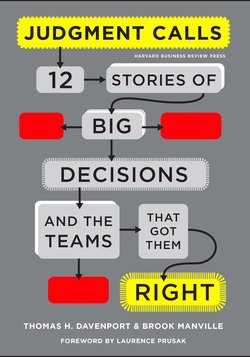Читать книгу Judgment Calls - Thomas H. Davenport - Страница 10
На сайте Литреса книга снята с продажи.
Patterns of Change in Today's Organizations
ОглавлениеA sea change is under way in many organizations today, as we observe where and from whom judgment is valued, and how it gets exercised in contemporary decision making. The changes—decision making more among frontline workers, more distributed, more team based, and so forth—are consistent with the decline of the Great Man and the rise of the Great Organization and good organizational judgment. At least four major trends are beginning to shape a new pattern that we think will define good decision making in the future:
The recognition that “none of us is as smart as all of us.” Social media, prediction markets, involving customers in product development—all of these are evidence that leading organizations want to tap the wisdom of the crowd, as Jim Surowiecki put it in his seminal book.15 While involving multiple people in decisions can be unwieldy and doesn't always yield a better outcome, it is often both possible and likely to yield a better result.
The second trend is tapping not just the wisdom of the crowd, but the leadership of the crowd. While hierarchy and leadership from CEOs and presidents are not going away, there are increasing settings in which “collective leadership” is being employed. Of course, we are all familiar with the “open innovation” technologies of Linux and Firefox, but that is only one model. As Mehrdad Baghai and Jim Quigley, the former CEO of Deloitte, have noted in a recent book, there are a variety of collective leadership “archetypes” based on whether the work structure is emergent (as in, for example, community organizing with volunteers) or directive (as in the relationship between a general and soldiers), and whether the work itself is scripted (as in an orchestra) or creative (as in an improv play).16 These dimensions open up multiple ways for many to work as one, and for organizations to benefit from leadership and decision making by multiple contributors. This means, of course, that the organization would also benefit from efforts to improve the decision-making capabilities of its collective leaders.
The use of data and analytics to support—and sometimes actually make—decisions. Intuition will never vanish—nor should it—but there is plenty of evidence that when data or scientific evidence is available, they lead to better decisions than intuition alone. Some organizations are “competing on analytics,” while others are simply using them as an occasional aid to better decisions.17 It may be romantic to believe that we can “thin-slice” our way to better decisions, as Malcolm Gladwell argues in Blink, but the fact is that good decisions typically require systematic analysis. Even some of Gladwell's examples of supposed thin-slicing actually used detailed analysis—such as the marriage scientist John Gottman.18 He can tell you in a few minutes of observation whether you are likely to stay married to your spouse, but he can only do so after decades of behavior and speech coding, and deep statistical analysis of it.
The fourth relatively new factor is one that has continued to alter so many aspects of business and life more generally: information technology. It doesn't create better organizational judgment directly, but it's definitely an enabler of the other changes we have mentioned. While early applications of IT have primarily been about better transactions, over the last decade or so they have firmly entered the realms of knowledge, insight, and judgment. Technology makes possible the changes above of increased participation and analytical decision support. It also allows for the capture and distribution of many forms of explicit and even implicit knowledge. While judgment has historically been a subject that addressed human rather than technological capabilities, no current account of the nature of judgment would be complete without significant mention of the latter's role.
All of these changes come at a time when external conditions in the world have made getting decisions right more important than ever. Businesses face ever-higher levels of competition, and in a climate of increasing economic uncertainty and volatility, markets and customers move faster than ever before. Further, the same technologies that make it easier to tap collective wisdom within organizations also create more transparency into them; the punishment for getting big decisions wrong is swift and stern.
Of course, many things haven't changed in the world of organizational judgment. As we hope our stories will demonstrate, good judgment and consistently good decision making require such eternal verities as good leadership, strong culture and values, accountability, and good decision processes. These are widely emphasized in the decision-making literature, but rarely in combination with the four new factors that have transformed the judgment environment.
